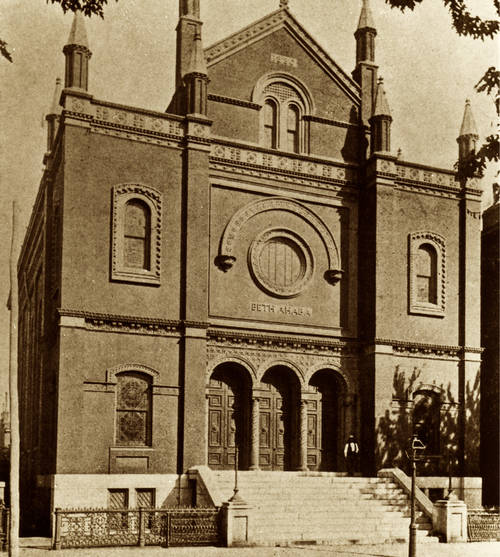History
.

Jews were doing business in the Virginia Territory as early as 1650, and by the 1760s they began to settle in Richmond. In 1789, when Jewish residents numbered about 100 of the city’s 3,700 residents, Kahal Kadosh Beth Shalome (The Holy Congregation, House of Peace) was organized in the Sephardic tradition. It was the first congregation in Richmond and the sixth and westernmost in the United States, founded just three years after the Virginia General Assembly enacted the Statute for Religious Freedom. By 1822, K.K. Beth Shalome members worshipped in the first synagogue building in Virginia, at a site on Mayo Street.
A growing number of German and Eastern European Jews immigrated to Richmond and joined the congregation, but soon longed for their more familiar form of Ashkenazic worship. In 1841, they founded Congregation Beth Ahabah – House of Love – as an offshoot of K.K. Beth Shalome. The first minister, called to its pulpit in 1846, was the Reverend M.J. Michelbacher of Philadelphia.
Under Rabbi Michelbacher’s leadership, Beth Ahabah founded the first Jewish school in Richmond in 1846 and built its first synagogue in 1848 at Eleventh and Marshall streets. Beth Ahabah’s school was a particularly excellent institution, attended by Christian as well as Jewish children, and when the Richmond public school system was established in 1871, the congregation provided its schoolrooms, rent-free, to the city until proper schools could be built.
The congregation moved toward Reform in 1867 with discussion of acquiring an organ, the decision to switch to family pews (mixing men and women) and allowing women to join the choir. Beth Ahabah joined the Reform movement’s Union of American Hebrew Congregations in 1875. A new building was erected, also at Eleventh and Marshall, in 1880. In 1898, K.K. Beth Shalome formally consolidated with Congregation Beth Ahabah.
The growth of the congregation necessitated a larger synagogue, and on March 4, 1904, the cornerstone was laid for its present building at 1117 W. Franklin St. The structure was dedicated just nine months later, on December 9, 1904. The synagogue was designed by the Richmond-based firm of Noland and Baskervill, noted for other area landmarks like nearby St. James’s Episcopal Church and the wings of the Virginia State Capitol. Its design reflects the neo-classical architectural style popular at the turn of the century and is believed to have been patterned after Thomas Jefferson’s home, Monticello, and the Rotunda at the University of Virginia.

The synagogue’s history and its magnificent architecture are captured in “Congregation Beth Ahabah,” designed, written and photographed by members and volunteers Linda Held Wren, Claire Millhiser Rosenbaum and Chuck Savage.
It is available online here.
In 2021, the Branch Museum of Architecture and Design featured Beth Ahabah in a webinar series.
Click here to watch the webinar and for more information!
Credit:
Photo: Chuck Savage




